Summary
Revista Brasileira de Ginecologia e Obstetrícia. 2009;31(9):440-446
DOI 10.1590/S0100-72032009000900004
PURPOSE: to verify the occurrence ratio of pica in pregnant women and its impact on the mother and newborn health. METHODS: prospective study with 227 adult pregnant women and their newborns treated at the Maternity School of Universidade Federal do Rio de Janeiro, between 2005 and 2006. Pica has been considered as the ingestion of inedible substances or atypical food combinations. The data was collected was done by medical chart review and interview. RESULTS: Pica was referred to by 14.4% of the women, 42.1% of whom practiced it daily. The onset occurred in the second gestational trimester in 46.7% of the cases, and, in the third trimester, in 30% of them. Among the alleged reasons, 65% of the women were unable to give them, 15% declared relief of nausea and heartburn and 10% reported reduced stress and anxiety. The practice in the previous gestation/puerperium was referred to by 15% of the women. Pica was not associated with the maternal anthropometric condition, the skin color, the marital status, the maternal schooling and the presence of parasitosis. There was no difference between the average of the total family income and the number of gestations for the women who did or did not have pica. Pica was associated with gestational anemia (p<0.009) and gestational intercurrences (OR=3.5; CI95%=1.6-7.9). As for the baby, pica did not interfere in the health parameters at birth: weight, gestational age and intercurrences. CONCLUSIONS: pica must be investigated at prenatal assistance and recognized as a risk factor for the mother's health.
Summary
Revista Brasileira de Ginecologia e Obstetrícia. 2009;31(9):461-467
DOI 10.1590/S0100-72032009000900007
PURPOSE: to evaluate the expression of erbB-2 and of the estrogen and progesterone (ER/P) hormonal receptors in the transition regions between the in situ and the invasive fractions of ductal breast neoplasia (ISDC and IDC, respectively). METHODS: Eighty-five cases of breast neoplasia, containing contiguous ISDC and IDC areas, were selected. Histological specimens from the ISDC and the IDC areas were obtained through the tissue microarray (TMA) technique. The erbB-2 and the ER/PR expressions were evaluated through conventional immunohistochemistry. The McNemar's test was used for the comparative analysis of the expressions of erbB-2 protein and the ER/PR in the in situ and invasive regions of the tumors. The confidence intervals were set to 5% (p=0.05). Intraclass correlation coefficients (ICC) were calculated to assess the cross-tabulation agreement of the erbB-2 and the ER/PR expression in the ISDC and the IDC areas. RESULTS: the erbB-2 expression has not differed between the ISDC and the IDC areas (p=0.38). Comparing the two areas in each case, there was agreement in the expression of erbB-2 (ICC=0.64), PR (ICC=0.71) and ER (ICC=0.64). Restricting the analysis to tumors with the in situ component harboring necrosis (comedo), the ICC for erbB-2 was 0.4, compared to 0.6 for the whole sample. In this select group, the ICC for PR/ER did not differ substantially from those obtained with the complete dataset: as for the ER, ICC=0.7 (versus 0.7 for the entire sample) and for PR, ICC=0.7 (versus 0.6 for the entire sample). CONCLUSIONS: our findings suggest that the erbB-2 and the ER/PR expressions do not differ in the contiguous in situ and invasive components of breast ductal tumors.
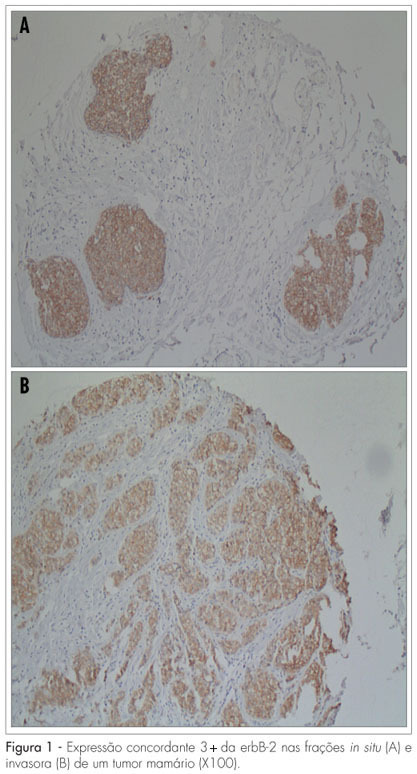
Summary
Revista Brasileira de Ginecologia e Obstetrícia. 2009;31(9):453-460
DOI 10.1590/S0100-72032009000900006
PURPOSE: to evaluate the effects of the administration of two synthetic steroids in the uterus morphology and in the reproductive parameters of adult female rats. METHODS: divided into four experimental groups: control (C; physiological solution); treated with nandrolone decanoate (DN; 7.5 mg/kg of body weight); with a testosterone esters compound (T; 7.5 mg/kg); and simultaneously with DN and T (7.5 mg/kg of each steroid), in a single intraperitoneal weekly dose, for eight weeks. Five females of each group were sacrificed and the uterine horns were collected, weighted and prepared for histological and morphometrical evaluation. The remaining rats were mated with normal male rats for reproductive parameters evaluation, composing the groups treated during the pre-gestational period. Another group of 20 female rats were treated during the gestational period (7th-14th days). For data analysis, the Kruskal-Wallis non-parametric variance analysis was used, followed by the test of Dunn or of Student-Newman-Keus (5% significance level). RESULTS: there was a significant body weight increase in the androgenized females (ND: 305±50; T: 280±35; ND+T: 275±30 versus C: 255±22 g; p<0.05). Uterine weight was not affected by the steroidal treatment (ND: 0.6±0.2; T: 0.4±0.04; ND+T: 0.7±0.1 versus C: 0.4±0.09 g). All the androgenized females presented estral acyclicity and endometrium characterized by papilliferous luminal lining, oedematous stroma with hemorrhagic areas and secretory activity. There were changes in the morphometrical thickness parameters of the luminal epithelium, myometrium and perimetrium in the androgenized groups. None of the female rats got pregnant when treated with steroids in the pre-gestational period and the treatment during organogenesis affected negatively the reproductive parameters. CONCLUSIONS: steroidal agents alter the uterine structure and impair fertility and gestational outcome in female rats.
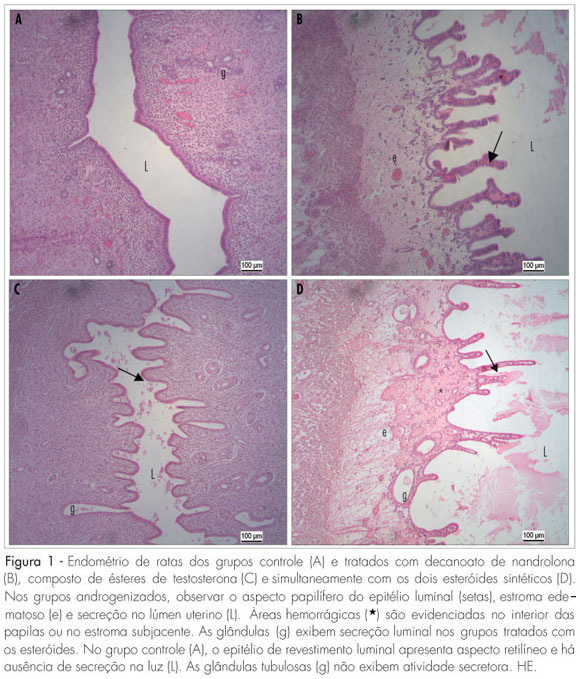
Summary
Revista Brasileira de Ginecologia e Obstetrícia. 2009;31(9):433-439
DOI 10.1590/S0100-72032009000900003
PURPOSE: the main goal of this study is to evaluate the emotional conditions among mothers of newborns with visible malformation (Group M) and mothers of eutrophic newborns (Group E) soon after birth. METHODS: twenty-two mothers from the Group M were matched by age and number of children to 22 mothers of the Group E. They were assessed through the Beck Depression Inventory (BDI) and the State-Trait Anxiety Inventory (STAI). The data were complemented by interviews and analyses of the medical files of both mother and child. RESULTS: the results have shown significant differences in the mean scores of the three subscales (trait anxiety, state anxiety, dysphoria/depression) between the two groups of mothers. In terms of clinical signs, there were a significantly larger percentage of mothers from Group M identified with depression and anxiety after the child's birth, and for both conditions when compared with mothers from Group E. Although the results may reflect characteristics of the maternal personality, the trait anxiety was significantly more evident in mothers of malformed children, especially due to the child's health condition, its referral to the ICU and his/her condition regarding their future life. CONCLUSION: the percentage of mothers with clinical depression and anxiety suggests the need for either individual or group support to attend the needs of the mothers and mitigate the adverse effects of stressors throughout the child's development. Support should also be provided during pregnancy, when the mothers currently receive the news about the malformation.
Summary
Revista Brasileira de Ginecologia e Obstetrícia. 2009;31(8):391-396
DOI 10.1590/S0100-72032009000800004
PURPOSE: to study the changes in the urethrovesical junction (UVJ) and in the proximal urethra (PU) caused by the Marshall-Marchetti-Krantz-Burch (MMK-B) combined surgery through perineal ultrasonography. METHODS: an interventional, longitudinal and prospective study has been conducted. Thirty-two women with stress urinary incontinence were submitted to perineal ultrasonography before and 30 days after surgery to evaluate the pubo-urethral distance (PUD), the proximal urethra length, the UVJ horizontal distance (UVJHD) and the UVJ vertical distance (UVJVD), the patient being at rest, and in effort during the Valsava manoeuvre. Results have been expressed in mean and standard deviation. The Student's t-test has been used to compare pre and postoperative results whenever the variables fulfilled the normality test criterion; otherwise, the Wilcoxon's paired test has been used. RESULTS: as compared with the preoperative measures, the Marshall-Marchetti-Krantz-Burch surgery has reduced the PUD at rest (14 mm x 4.3 mm) and during effort (20.8 mm x 6.4 mm); has reduced the UVJHD at rest (14 mm x 4.3 mm) and during effort (20.8 mm x 6.4 mm); has increased the PU length at rest (16.7 mm x 19.7 mm) and during effort (1.6 mm x 15.4 mm); and has increased UVJVD during effort (-5.4 mm x 14.8 mm), but has not changed it at rest (16.2 mm x 18.7 mm, p = 0.085). CONCLUSIONS: the Marshall-Marchetti-Krantz-Burch surgery has significantly reduced the urethrovesical junction vertical and horizontal mobility without raising the urethrovesical junction.
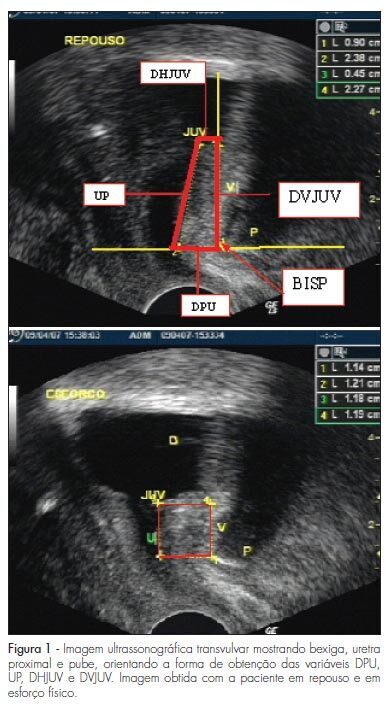
Summary
Revista Brasileira de Ginecologia e Obstetrícia. 2009;31(8):385-390
DOI 10.1590/S0100-72032009000800003
PURPOSE: to evaluate the effect of hyperprolactinemia induced by metoclopramide on the endometrium and myometrium of female mice in the proestrus phase. METHODS: 24 female mice were randomly divided in two groups: CtrG/control and ExpG/treated with metoclopramide (6.7 mg/g daily). After 50 days, the animals were sacrificed in the proestrus phase, and the blood was collected to determine the levels of estradiol, progesterone and prolactin. The uterine horns were removed, fixed in 10% formaldehyde and processed before being included in paraffin. Slices of 4 µm were stained by hematoxylin and eosin (H/E). In the morphological analysis, a Carl Zeiss light microscope, with objectives varying from 4 to 400 X was used for each histological slice characterization. In the morphometrical analysis, the superficial epithelium, the lamina propria and the myometrium thickness were evaluated, with the help of an image analyzer (AxionVision - Carl Zeiss) attached to the light microscope (Carl Zeiss). The statistical analysis was done by ANOVA, followed by the Wilcoxon test. P-value was considered as significant, when <0.05. RESULTS: our findings have shown an increase in the seric levels of prolactin (295.6±38.0 ng/mL) and significant decrease in the progesterone levels (11.3±0.9 ng/mL) in the ExpG, as compared to the CtrG (45.5±5.2 ng/mL and 18.2±1.6 ng/mL, respectively; p<0.001). Concerning the seric level of estradiol, significant differences between the groups were not obtained (ExpG=119.1±12.3 pg/mL and CtrG=122.7±8.4 pg/mL; p=0.418). The morphological study has shown that the uterus from the ExpG presented the endometrium with more developed superficial epithelium and lamina propria, as compared to the CtrG, the same happening with the myometrium. The thickness morphometrical values of the luminal epithelium (8.0±1.1 µm) and endometrium (116.2±21.1x10² µm) from the CtrG were lower than the ones from the ExpG (10.2±0.8 µm and 163.2±23.3x10² µm, respectively) with p<0.05. Nevertheless, data obtained in the myometrium have not shown significant differences between the groups (CtrG=152.2±25.2x10² µm and ExpG=140.8±18.0x10² µm). CONCLUSIONS: data have shown that hyperprolactinemia induced by metoclopramide determines endometrial proliferation and interferes with the ovarian function, mainly in the progesterone production.
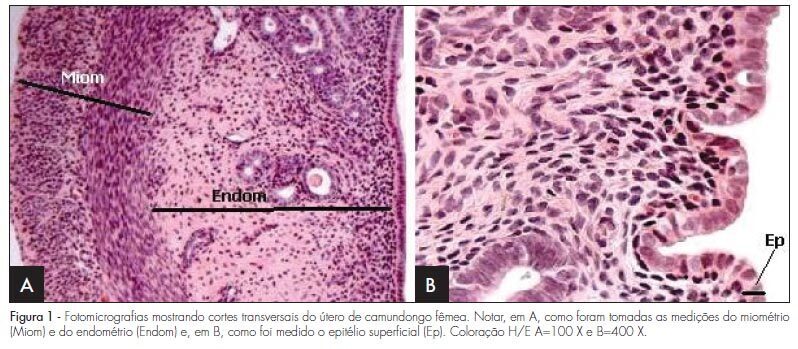
Summary
Revista Brasileira de Ginecologia e Obstetrícia. 2009;31(8):380-384
DOI 10.1590/S0100-72032009000800002
PURPOSE: to determine weight variation in women with different Body Mass Index (BMI) in use of trimestral injections of depot-medroxyprogesterone acetate (DMPA), and compare it to women users of a non-hormonal method. METHODS: retrospective study with the chart review of 226 DMPA users and 603 controls, users of DIU TCu380A. Women were distributed in categories, according to their initial BMI, as having normal weight (<25 kg/m²), overweight (25 to 29,9 kg/m²) and being obese (>30 kg/m²), and were followed-up for six years, with yearly measurements of weight and BMI. The statistic test ANOVA was used to measure the weight variation among the groups in each BMI category every year. RESULTS: the average age at the onset of the method employed was higher in the study group than in the controls, in all the BMI categories: 31.6±SD 7.1 X 27.4±SD 5.5 in the normal weight category (p<0.0001); 37.3±SD 6.8 X 29.2±SD 6.0 in the overweight category (p<0.0001); and 35.3±SD 6.4 X 29.7±SD 5.8 among obese women (p<0.0001). DMPA users showed weight increase as compared to the controls in the overweight category (p=0.0082); and the weight increase along the observation period was also higher among the DMPA users than among the controls, for the normal weight (p<0.0001) and overweight (p=0.0008) categories. In the obese group, there was no BMI variation between the groups, nor along the period during which they were using the method. CONCLUSIONS: there was no change in weight gain among DMPA users from the obese category. Prospective studies should be done with metabolic tests to establish the determining factors of weight gain in normal and overweight women.
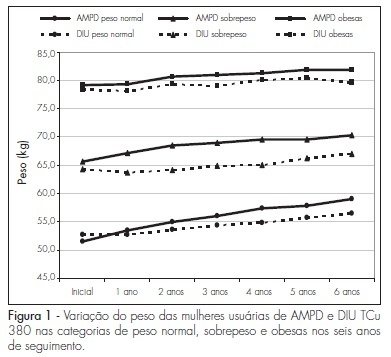
Summary
Revista Brasileira de Ginecologia e Obstetrícia. 2009;31(7):361-366
DOI 10.1590/S0100-72032009000700007
PURPOSE: to identify sensitivity alteration in the intercostal brachial nerve pathway using an extensiometer, and to observe the measurement reproducibility of the apparatus. METHODS: the Semmes-Weinstein extensiometer was used to evaluate the sensitivity along the intercostal brachial nerve pathway. Ninety-four women have participated in the study, divided into two groups: a CA Group composed of 47 women submitted to breast cancer axillary lymphadenectomy, and a comparative group composed of 47 women without breast cancer, who had not been submitted to any kind of axillary surgery. Each participant underwent anamnesis and two consecutive applications of the extensiometer. The Control Group responses to the extensiometer test were used as normality reference values. RESULTS: based on Control Group responses, the prevalence of sensitivity changes was 85.1% in the CA Group. Reproducibility of the extensiometer application was confirmed in the CA Group through the Kappa's test (p=0.8). CONCLUSIONS: in this studied sample, sensitivity alterations had high prevalence; evaluations made with the extensiometer were reproducible, and thus we consider the equipment reliable to evaluate sensitivity along the intercostal brachial nerve pathway.